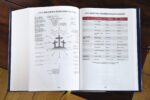Discover the 5 Covenants in the Bible

Content adapted from the NIV Zondervan Study Bible. Don’t own your own copy? Click here to view your buying options.
Covenant is one of the most important theological ideas in biblical theology. It is reflected in the traditional labels Old and New Testaments, i.e., covenants. The concept exists at significant points in the Bible’s storyline and is the theological glue that binds promise to fulfillment. So the biblical history of salvation and the unfolding of God’s covenants are almost synonymous.
Although the Bible does not explicitly mention a covenant until Gen 6:18 (when God announces that he intends to establish a covenant with Noah), many believe that God made a covenant with Adam (cf. Hos 6:7; see NIV text note there). They refer to this covenant with Adam as “the covenant of works” or a “covenant with creation.” Others, however, while not denying that God had a relationship with Adam involving mutual obligations, distinguish this from a covenant, which involves additional formalizing elements such as a sworn and/or enacted oath. Understanding covenant in the more formal sense, the first divine-human covenant is the one God established in the days of Noah (cf. Isa 54:9). That covenant affirms God’s commitment to creation after the flood.
However, while the concept of a covenant may not appear until after the flood, the major divine-human covenants (Noahic, Abrahamic, Mosaic, Davidic, and the new covenant) all support and advance God’s creative (and redemptive) goal. Each covenant provides further divine assurance that God will realize his purpose for creation in general and humanity in particular by fully establishing his kingdom on earth.
The Universal/Noahic Covenant
While God announces his covenant with Noah and all creation prior to the flood (Gen 6:18), he establishes it after the deluge subsides (Gen 8:20—9:17). The first mention of this covenant simply highlights God’s plan to preserve Noah and the others in the ark (Gen 6:18). God’s covenant with Noah reaffirms his original creational intent that the flood had “disrupted.” So he solemnly promises that a suspension of the natural order will never again interrupt (Gen 8:21–22; 9:11–15) the fulfillment of humanity’s creational mandate (cf. Gen 1:26–30; 9:1–7). Moreover, the additional commands (Gen 9:4–6) emphasize the value of human life in particular, which further highlights the primary rationale for this covenant: preserving life on earth without further divine interruption. It is at least implicit from the scope of this covenant that God’s redemptive goal will ultimately encompass the whole creation. That global emphasis in Gen 1–11 is not lost in the subsequent chapters of Genesis and beyond, despite their narrowing focus.
The Abrahamic Covenant
The promises encompassed by the patriarchal covenants (those God established with Abraham, Isaac, and Jacob) are recorded in Gen 12:1–3. The essence of these divine promises is that God would bless Abraham in two ways: (1) God would make him into a great nation and so make his name great, and (2) through him God would mediate blessing to others (i.e., all peoples on earth). Significantly, each of these two aspects are subsequently ratified by covenant: (1) the national dimension of God’s promise is the focus of Gen 15, where God establishes (lit. “cuts”) “a covenant with Abram” (Gen 15:18); (2) the international dimension of the promise is apparently ignored in Gen 15, but it is alluded to in Gen 17 (cf. vv. 4–6,16), where God announces an “everlasting covenant” (Gen 17:7), the so-called “covenant of circumcision” (Acts 7:8). While many hold that the latter simply elaborates or enhances the covenant already established back in Gen 15, the different circumstances and emphases at very least suggest that this is a significant second stage in God’s covenant history with Abraham. Indeed, if Gen 17 is read in conjunction with Gen 22 (see below), these chapters arguably present a second covenant—one that is distinct from, but related to, the earlier covenant established in Gen 15.
The first of these covenants (Gen 15) formally ratified God’s promise to make Abraham into a “great nation” (Gen 12:2), thus the primary focus is on how God will work out his creative goal in Abraham’s biological “offspring,” subsequently identified as the sons of Jacob (Israel).
This, however, was only the preliminary stage in God’s unfolding plan of redemption. The second stage relates to how Abraham, through that great nation descended from him, would mediate blessing to “all peoples on earth” (Gen 12:3). This seems to be the main focus in Gen 17 and 22.
Even though the promise of nationhood is not altogether absent in Gen 17 (cf. v. 8), stress is placed on “nations,” “kings,” and a perpetual divine-human relationship with Abraham’s “offspring” (Gen 17:4–8,16–21). Significantly, particular focus is placed on Isaac (Gen 17:21; cf. Gen 21:12) as the one through whom this covenant will be perpetuated, highlighting what was at stake in the divine test of Gen 22. There Abraham’s obedient faith (Gen 22:16b,18b) met the demands of Gen 17:1 (cf. Gen 18:19; 26:5), thus prompting God to ratify the promises of Gen 17 (cf. Gen 22:17–18a; 26:4) by a solemn oath (Gen 22:16a; cf. 26:3).
Thus understood, two distinct covenants were established between God and Abraham. The first (Gen 15) guaranteed God’s promise to make Abraham into a “great nation.” The second (anticipated in Gen 17 and ratified by divine oath in Gen 22) affirmed God’s promise to bless all nations through Abraham and his “offspring.”
The Mosaic Covenant
God established the Mosaic covenant just after a significant development anticipated in Gen 15 had taken place: the emancipation of Abraham’s descendants from oppression in a foreign land (cf. Gen 15:13–14; Exod 19:4–6; 20:2). The focus at Sinai is less on what Abraham’s descendants must do in order to inherit the land and more on how they must conduct themselves within the land as the unique nation that God intended them to be (Exod 19:5–6). In order to be God’s “treasured possession,” “kingdom of priests,” and “holy nation” (Exod 19:5–6), Israel must keep God’s covenant by submitting to its requirements (i.e., the stipulations set forth in Exod 20–23). By adhering to these and the subsequent covenant obligations given at Sinai, Israel would be manifestly different from other nations and thus reflect God’s wisdom and greatness to surrounding peoples (cf. Deut 4:6–8).
By such means, Abraham’s descendants would not only follow in the footsteps of their ancestor (cf. Gen 26:5) but also facilitate the fulfillment of God’s promises (Gen 18:19). Thus, like Abraham, Israel must “walk before [God] faithfully and be blameless” (Gen 17:1). Failing to do so would undermine the very reason for Israel’s existence, a lesson that the golden calf incident so graphically illustrates (Exod 32–34). Although God reestablished the covenant (Exod 34), this was an act of grace rather than justice (Exod 34:6–7). Moreover, by reissuing the same covenant obligations at the end of this incident, God demonstrated that Israel’s responsibility had not changed.
Israel had to obey God in order to fulfill his purpose for delivering them from Egypt and subsequently giving them the promised land: They were to be his priestly kingdom and holy nation. By reflecting God’s holiness (Lev 19:2), Israel would showcase true theocracy and thus serve as God’s witnesses to a watching world. Moreover, since human rebellion threatened to jeopardize God’s ultimate objective (i.e., blessing all nations through Abraham’s “offspring”), the Mosaic covenant also encompassed the means by which the divine-human relationship between Yahweh and Israel could be maintained: Sacrificial worship, particularly on the Day of Atonement (Lev 16), would ritually atone for Israel’s sin and symbolically express God’s forgiveness. Therefore, just as the Noahic covenant guaranteed the preservation of human life on earth, so the Mosaic covenant guaranteed the preservation of Israel, Abraham’s great nation, in the land. Such was crucial for the next stage in fulfilling God’s promises: establishing a royal line through which Abraham’s ultimate “seed” and covenant heir would eventually come (cf. Gal 3:16).
The Davidic Covenant
After Sinai, the next major covenantal development comes with Nathan’s message to David (2 Sam 7; 1 Chr 17). David intends to build a “house” (i.e., temple) for God, but God promises to build a “house” (i.e., dynasty) for David. Neither 2 Sam 7 nor 1 Chr 17 explicitly describes God’s promise as a “covenant,” but several other texts do (cf. 2 Sam 23:5; 2 Chr 7:18; 13:5; Ps 89:3; Jer 33:21).
The Davidic covenant continues the trajectory of both the Mosaic and Abrahamic covenants. God’s plans for David and Israel are clearly intertwined (cf. 2 Sam 7:8–11, 23–26). Moreover, significant parallels link David to Abraham:
• God promises both a great name (Gen 12:2; 2 Sam 7:9).
• In the future both will conquer their enemies (Gen 22:17; 2 Sam 7:11; cf. Ps 89:23);
• Both have a special divine-human relationship (Gen 17:7–8; 2 Sam 7:24; cf. Ps 89:26).
• A special line of “offspring” perpetuates both of their names (Gen 21:12; 2 Sam 7:12–16).
• The descendants of both must keep God’s laws (Gen 18:19; 2 Sam 7:14; cf. Pss 89:30–32; 132:12).
• The offspring of both would mediate international blessing (Gen 22:18; Ps 72:17).
The Davidic covenant thus identifies more precisely the lineage of the “offspring” who will mediate international blessing: He will be a royal descendant of Abraham through David.
This covenant therefore introduces a subtle but significant shift in focus. With the great nation promised to Abraham now firmly established (2 Sam 7:1), attention zooms in on his royal progeny (cf. Gen 17:6, 16). This royal line, already traced explicitly in Genesis (cf. Gen 35:11; 49:10; see also Gen 38; Ruth 4:18–22), culminates in an individual, conquering “offspring” who fulfills the promise of Gen 22:18 and the hope expressed in Ps 72:17.
The New Covenant
Persistent failure to live according to God’s covenant requirements led to inevitable disaster for both the nation and its monarchy, culminating in judgment: the destroyed temple and Babylonian exile. This might have spelled the end had God’s plans for Israel not been crucial for fulfilling his covenant promises. The exile of the nation and the demise of the monarchy had to be overcome for God’s creation plan to be realized. Covenant history thus continued through the prospect of a “new covenant”—one that would be both continuous and discontinuous with those of the past.
Though referred to explicitly as a “new covenant” only once in the OT (Jer 31:31), several passages, both in Jeremiah and elsewhere, allude to it. In Isaiah this everlasting covenant of peace is closely associated with the servant figure (Isa 42:6; 49:8; 54:10; 55:3; 61:8). It is inclusive in that it incorporates even foreigners and eunuchs (Isa 56:3) but also exclusive in that it is confined to those who “hold fast to” its obligations (Isa 56:5–6; cf. 56:1–2).
While Jeremiah and Ezekiel use different terminology to describe it, both anticipate a fundamental change taking place in the covenant community: Jeremiah speaks of internalizing the Torah (Jer 31:33), whereas Ezekiel speaks of spiritual surgery and radical transformation (Ezek 36:26–27). For both prophets, this inner renewal would result in the ideal divine-human relationship, which this and earlier covenants express in terms of the covenant formula “I will be their God, and they will be my people.” In this new covenant, all the hopes and expectations of previous covenants will attain climactic fulfillment and eschatological expression.
It is unsurprising, therefore, that the New Testament (“covenant”) declares that all God’s covenant promises are realized in and through Jesus (cf. Luke 1:54–55, 69–75; 2 Cor 1:20), the long-awaited Davidic Messiah (Matt 1:17–18; 2:4–6; 16:16; 21:9; Luke 2:11; John 7:42; Acts 2:22–36). As the ultimate offspring of Abraham (Matt 1:1; Gal 3:16) and royal offspring of David (Matt 1:1; Luke 1:27, 32–33; 2:4; Rom 1:3; 2 Tim 2:8; Rev 5:5; 22:16), Jesus also fulfills the role of Isaiah’s servant (Acts 3:18; 4:27–28; 8:32–35)—not only in redeeming Israel (Luke 2:38; Acts 3:25–26; Heb 9:12, 15) but also by mediating God’s blessing to an international community of faith (Acts 10:1—11:18; 15:1–29; Rom 1:2–6; 3:22–24; 4:16–18; 15:8–12; Gal 3:7–14, 29).
According to the NT Gospels and letters, the new covenant was ratified through Jesus’ sacrificial death on the cross (cf. Matt 26:28; Mark 14:24; Luke 22:20; 1 Cor 11:25). In the inaugural Lord’s Supper, Jesus alludes to both the forgiveness linked by Jeremiah to the new covenant (Matt 26:28; cf. Jer 31:34) and the blood associated with the establishment of the old (i.e., Mosaic) covenant (Luke 22:20; cf. Exod 24:8. Accordingly, the NT emphasizes the forgiveness of sins, something only fully attainable under the new covenant (Acts 13:39; cf. Heb 10:4), as the primary benefit of Jesus’ death (e.g., Luke 1:77; 24:46–47; Acts 2:38; 10:43; 13:38; 26:18; Rom 3:24–25; Eph 1:7; Col 1:14; Heb 9:12, 28; 1 John 1:7; Rev 1:5; 7:14; 12:10–11).
Thus, according to both Paul and the writer of Hebrews, the new covenant is far superior to the old (i.e., the Mosaic covenant). Such is already implicit in the use of the adjective “new” in 1 Cor 11:25 (cf. Luke 22:20), which clearly alludes to Jeremiah’s negative contrast (Jer 31:31–32). Paul is even more pointed, however, in 2 Cor 3, where he explicitly contrasts the new and the old covenants, highlighting the vast inferiority of the old in comparison with the surpassing glory and permanence of the new. A similar, negative comparison is also made by his “figurative” contrast between Hagar and Sarah in Gal 4:21–31.
Analogous conclusions are drawn by the author of Hebrews. Having noted the superiority of the new covenant in Heb 7:22, the writer elaborates his point through an extended comment on Jer 31:31–34, which forms a literary bracket around much of the argument in Heb 8–10 (cf. 8:9–12; 10:16–17). Not only does Jesus exercise a permanent, perfect, and heavenly priesthood (Heb 7:23—8:6), but the covenant of which he is mediator “is established on better promises” (Heb 8:6b), explained in terms of an “eternal redemption” (9:12) and “eternal inheritance” (9:15) secured through the blood of Christ (Heb 9:11—10:18)—later described as “the blood of the eternal covenant” (Heb 13:20). Like Paul, therefore, the contrast is not between something bad and something good, but between something good (but temporal) and something better (because, unlike the old covenant, the new is unbreakable and eternal).
While these new covenant realities are in many respects already present (cf. Heb 9:11), it is nevertheless true that the best is still to come. Just as Israel’s restoration hopes were not exhausted in repatriation after the Babylonian exile, neither were they fully realized in the first coming of their Messiah. While in Jesus—the promised “seed” of Abraham (Gal 3:16), the anticipated prophet like Moses (Acts 3:22–23; cf. Deut 18:15; Matt 17:5), King David’s greater son (Matt 22:41–46), and the mediator of the new covenant (Heb 8:6)—God’s covenant promises for both Israel and the nations have come to fruition, the ultimate expression of God’s creative and redemptive goal awaits fulfillment in the eschatological reality of the new creation. Only then will the hope expressed in the age-old covenant formula be most fully experienced (Rev 21:3), for “the throne of God and of the Lamb will be in the city, and his servants will serve him … And they will reign for ever and ever” (Rev 22:3, 5).
Content adapted from the NIV Zondervan Study Bible. Don’t own your own copy? Click here to view your buying options.

















